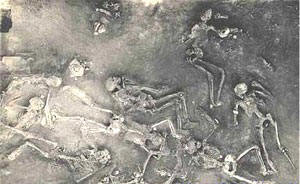Seven years after the nuclear tests in Alamogordo, New Mexico, Dr. J. Robert Oppenheimer, the father of the atomic bomb, was lecturing at a college when a student asked if it was the first atomic test conducted.
“Yes, in modern times,” he replied.
The sentence, enigmatic and incomprehensible at the time, was actually an allusion to ancient Hindu texts that describe an apocalyptic catastrophe that doesn’t correlate with volcanic eruptions or other known phenomena. Oppenheimer, who avidly studied ancient Sanskrit, was undoubtedly referring to a passage in “The Bhagavad Gita” that describes a global disaster caused by “an unknown weapon, a ray of iron.”
While it may be alarming to the scientific community to speak of the existence of atomic weapons before the present cycle of civilization, evidence of this phenomenon seems to whisper its verses in every corner of the planet.
Desert Glass
This evidence comes not only from the Hindu verses but also from ample extensions of fused glass fragments scattered throughout many deserts of the world. Silicon crystals, curiously cast, resemble remarkably the same fragments found after the nuclear explosions in Alamogordo’s White Sands atomic testing site.
In December 1932, Patrick Clayton, a surveyor from the Egyptian Geological Survey, drove between the dunes of the Great Sand Sea, close to the Saad Plateau in Egypt, when he heard crunching under the wheels. When he examined what was causing the sound, he found great chunks of glass in the sand.
The find caught the attention of geologists around the world and planted the seed for one of the biggest modern scientific enigmas. What phenomenon could be capable of raising the temperature of desert sand to at least 3,300 degrees Fahrenheit, casting it into great sheets of solid yellow-green glass?
While passing through Alamogordo’s White Sands missile range, Albion W. Hart, one of the first engineers to graduate from the Massachusetts Institute of Technology, observed that the chunks of glass left by nuclear tests were identical to the formations that he observed in the African desert 50 years earlier. However, the extension of the cast in the desert would require that the explosion be 10,000 times more powerful than that observed in New Mexico.
Many scientists have sought to explain the dispersion of large glass rocks in the deserts of Libya, the Sahara, Mojave, and many other places in the world, as products of gigantic meteorite impacts. However, due to the absence of accompanying craters in the desert, the theory doesn’t hold up. Neither satellite imagery nor sonar has been able to find any holes.
Furthermore, the glass rocks found in the Libyan Desert present a grade of transparency and purity (99 percent) that is not typical in the fusions of fallen meteorites, in which iron and other materials are mixed in with the cast silicon after the impact.
Even so, scientists have proposed that the meteorites causing the glass rocks could have exploded several miles above the surface of Earth, similar to the Tunguska Event, or simply rebounded in such a way that they carried with it the evidence of the impact, but leaving the heat from the friction.
However, this doesn’t explain how two of the areas found in close proximity in the Libyan Desert show the same pattern—the probability of two meteorite impacts so close is very low. Nor does it explain the absence of water in the tektite specimens when these areas of impact were thought to be covered in it some 14,000 years ago.
Mohenjo Daro’s Ancient Catastrophe
The city where culture emerged in the present-day Indus Valley is a great enigma. The rocks of the ruins have partially crystallized, along with its hazy inhabitants. Moreover, mysterious local texts speak of a period of seven days of gratitude toward flying cars called Vimana for saving the lives of 30,000 inhabitants from a horrific episode.
 In 1927, years after the discovery of the Mohenjo Daro ruins, 44 human skeletons were found on the outskirts of the city. The majority were found face down, lying in the street and holding hands as if a serious catastrophe had suddenly engulfed the town. In addition, some bodies present signs of unexplainable radiation. Many experts believe that Mohenjo Daro is an unequivocal sign of nuclear catastrophe two millennia before Christ.
In 1927, years after the discovery of the Mohenjo Daro ruins, 44 human skeletons were found on the outskirts of the city. The majority were found face down, lying in the street and holding hands as if a serious catastrophe had suddenly engulfed the town. In addition, some bodies present signs of unexplainable radiation. Many experts believe that Mohenjo Daro is an unequivocal sign of nuclear catastrophe two millennia before Christ.
Nevertheless, the city is the not the only ancient locale suspected to have gone nuclear. Dozens of buildings from the ancient world present bricks with fused rocks, like the heat test that modern scientists cannot explain:
Ancient forts and towers in Scotland, Ireland, and England
The city of Catal Huyuk in Turkey
Alalakh in northern Syria
The ruins of the Seven Cities, near Ecuador
Cities between the Ganges River in India and the Hills of Rajmahal
Areas of the Mojave Desert in the United States
In whatever place of the world, the presence of an abysmal temperature and vivid descriptions of a terrible cataclysm suggest that there may have been an earlier epoch in which possibly nuclear technology was already known—an epoch in which atomic technology was turned against man.To purchase unique glass pieces that were found in the Libyan dessert along with other rare rocks please visit www.marmet-meteorites.com
Source: http://www.theepochtimes.com/n3/23630-ancient-atomic-bombs/
Also see: http://www.bibliotecapleyades.net/ancientatomicwar/esp_ancient_atomic_12.htm
Also see: http://www.indiadivine.org/audarya/spiritual-discussions/31909-atomic-warfare-ancient-india.html
Also see: http://knowtoomuch.info/post/8988893370/nuclear-events-in-ancient-india
Also see: http://www.bibliotecapleyades.net/ancientatomicwar/esp_ancient_atomic_12.htm
Also see: http://www.indiadivine.org/audarya/spiritual-discussions/31909-atomic-warfare-ancient-india.html
Also see: http://knowtoomuch.info/post/8988893370/nuclear-events-in-ancient-india











Geen opmerkingen:
Een reactie posten